
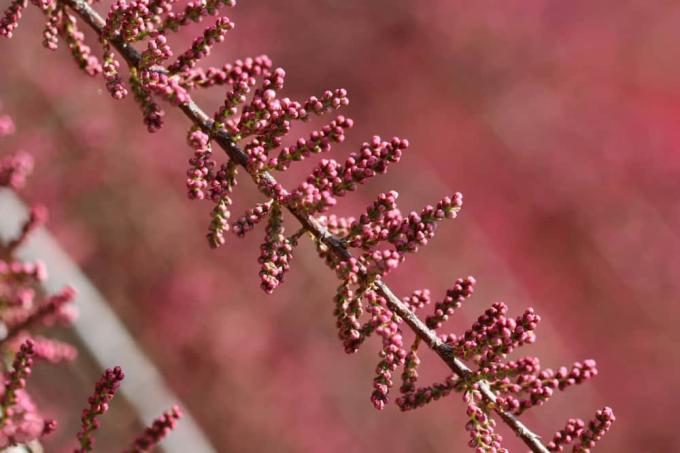
Table of contents
- Location
- watering and fertilizing
- Cut
- multiply
- plants in the bed
- plants in the bucket
- hibernate
- Conclusion
- Tips coming soon
Where the summer tamarisk spreads its elegantly curved branches, it protects against prying eyes and serves as a powerful windbreak. When the pink flowers unfold from July to September, they not only magically attract everyone's attention, but also busy bees and fluttering butterflies. The Tamarix ramosissima Rubra fulfills its tasks as a majestic solitaire just as charmingly as as a distinctive part of a combined flowering hedge. The ornamental tree says goodbye to the winter break with bright yellow leaves. The following care instructions explain all relevant aspects.
Location
With regard to the site conditions, the summer tamarisk proves to be extremely flexible. Basically, she thrives in any good garden soil, as long as there is enough light to develop the magical flowers. The ornamental shrub achieves its optimum in the following locations:
- Sunny to partially shaded light conditions
- Gladly in the protection of a high wall, a fence or a pergola
- Nutrient-rich, humus-rich soil
- Fresh-moist to sandy-dry
While salinity in the air and soil is not a problem along seashores, the summer tamarisk does not cope with compacted soil or waterlogging. If in doubt, amending the soil will fix the problem by incorporating either compost, leaf soil, sand or fine gravel.
watering and fertilizing
It comes as an incarnation of frugality, because a tamarisk Rubra is content with a minimum in terms of water and nutrient supply. If the horticultural diary is bursting at the seams again, she modestly takes a back seat, without vigor or flowering suffering as a result.
- Only water when there is no rain
- Always pour water directly to the roots
- Ideally water in the early morning or after sunset
- Summer tamarisk does not need fertilizer in the bed
In the narrowly limited substrate volume of a tub, on the other hand, increased nursing attention is required. Water here as soon as the surface of the potting soil feels dry. Planted in pre-fertilized soil, there is no need for fertilizer in the first year. After that, the ornamental tree receives a dose of liquid fertilizer for flowering plants every 4 weeks from April to August.
Tip:
A mulch layer of leaf soil, grass clippings or compost contributes to the well-being of a Tamarix in the bed.
Cut
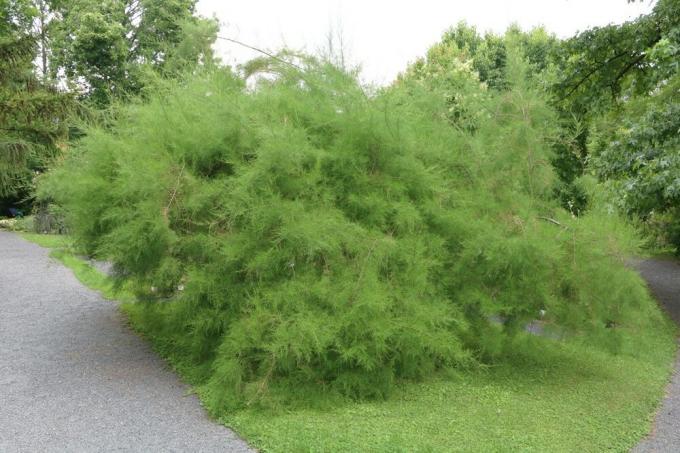
An annual topiary makes a valuable contribution to maintaining compact growth, a dense bloom and vitality. If you do not cut back, sooner or later the ornamental shrub will be bare from the inside. Ultimately, only a few flowers thrive at the ends of the widely spaced branches. To prevent this from happening, cut the summer tamarisk like this:
- The best time is an overcast, frost-free day in March or April
- In the first step, thin out the entire bush thoroughly
- Cut off dried branches at the base
- Cut off crossing and inward branches
- Shorten young shoots that are too long by a third or half at most
- The tamarisk only hesitantly sprout from a cut in the old wood
- Make each cut diagonally over an outward-facing bud
Tamarix ramosissima Rubra is an excellent candidate for high stem training. To do this, determine the strongest, straight-growing branch on a bush that is as young as possible as the main shoot. Remove all side shoots consistently up to the desired crown height. It is important to note that this main shoot towers over all other branches by 15 to 20 centimeters. This creates a harmonious appearance and an advantageous juice scale.
multiply
A vital summer tamarisk provides an abundance of suitable material for propagation by cuttings. When the wood is in full bloom in early summer, the best time for this form of offspring begins. How to do it:
- Cut off several semi-lignified shoot tips with a length of 15-20 centimeters
- Defoliate the lower part and cut away any buds that may be present
- Fill small pots with lean substrate, such as herb or propagation soil
- Put a cutting with the leafless part in there and water it
Place the seed pots in a warm, partially shaded garden area. You can force the rooting process by putting a plastic bag over it. This should be aired daily to prevent mold from forming. During the following weeks, the substrate must neither dry out nor be completely submerged in water. If the process goes as desired, fresh shoots will soon appear or the first roots will grow out of the opening in the ground. Once the summer tamarisk has fully rooted the pot, plant the young shrub in the bed or bucket.
plants in the bed
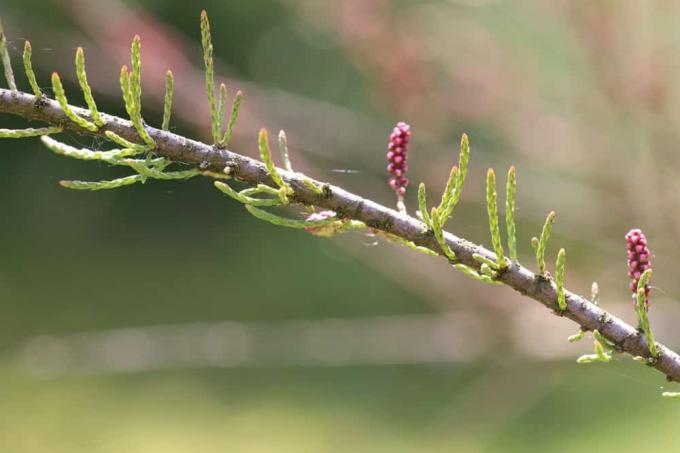
For hardy ornamental trees, such as Tamarix ramosissima Rubra, planting time is twice a year. The shrub grows both in autumn and early spring, provided the soil is not frozen. How to do it step by step:
- Put the summer tamarisk, which you have propagated yourself or bought ready-made, in water
- Meanwhile, rake, weed and finely chop the soil at the chosen location
- The ideal planting pit has twice the volume of the root ball
- Optimize the excavation with compost, manure, sand or granulated cattle manure
- Repot the young bush, plant in the middle and water generously
A distance of at least 150 centimeters is ideal for planting in a group or as a hedge.
Tip:
If you shorten the summer tamarisk by about a third in the last step of a planting, this measure promotes further branching and growth.
plants in the bucket
Thanks to its pruning tolerance, the ornamental tree is recommended for cultivation in large tubs. The Tamarix serves as a decorative screen and windbreak in exposed seating areas in the garden or on the terrace. If you place the shrub on the balcony, the not inconsiderable weight should be considered.
Structurally stable potting soil is primarily considered as the substrate in the planter. In contrast to commercially available potting soil, it does not tend to compact. The addition of a handful of sand and perlite is recommended. The process of planting differs little from inserting into the garden soil. The only thing worth emphasizing is the use of drainage over the water outlet as protection against harmful waterlogging. Inorganic material such as grit, pebbles or crushed potsherds is piled up to a height of 5 centimetres. Add a water- and air-permeable fleece between the substrate and the drainage so that no crumbs of earth get stuck.
hibernate
A summer tamarisk proves to be unlimitedly winter-hardy in the bed. However, light protection is recommended until the ornamental shrub has become well established. In the year of planting, the root area should therefore be piled up with leaves, straw or earth. The still young shoots receive a hood made of jute or garden fleece.
A Tamarix ramosissima Rubra in a bucket, on the other hand, requires protection against frost every year. Since the root ball could freeze through, the planter is wrapped thickly in bubble wrap or jute. Ideally, place the pot on an insulating base made of wood or styrofoam in front of the south wall of the house. If the snow fails to supply moisture, water the ornamental shrub in the bed and tub on a frost-free day.
Tip:
A tamarisk is neither fertilized nor cut from September so that it fully matures before winter.
Conclusion
A summer tamarisk rounds off the ornamental and cottage garden. Its lavish abundance of flowers thrives in both sunny and partially shaded locations and in any good garden soil. Thanks to its tolerance to drought, the Tamarix ramosissima Rubra adorns even tricky locations where a strong wind can sometimes blow. The ornamental tree makes only low demands on care, because it is satisfied with watering when it is dry and cutting in spring. If you want more specimens, propagation is very easy with cuttings.
Tips coming soon
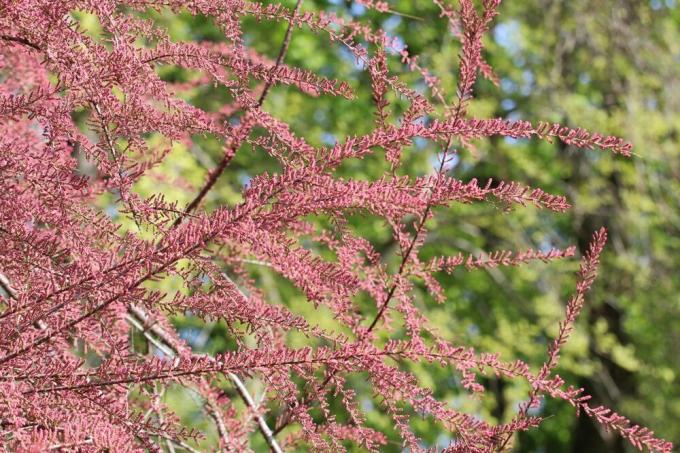
Location
- The location should be sunny.
- The more sun the plant gets, the better it develops.
- The wood needs neither winter nor wind protection and is very robust.
- The arching growth comes into its own when the summer tamarisk stands alone, as a solitaire.
plant substrate
- The soil must be permeable: We recommend a slightly sandy substrate, dry to fresh.
- The pH value is slightly acidic to alkaline.
- The good thing is that the summer tamarisk also grows in nutrient-poor soil.
- This tamarisk does not get along so well with heavy soils.
- The summer tamarisk doesn't like being moved. She resents that at times.
watering and fertilizing
- The summer tamarisk comes from the south and can therefore handle drought very well.
- It does not tolerate wet well.
- A permeable and, if possible, drained soil is recommended so that excess water can drain off.
- Fertilization is not necessary.
wintering
- Hibernation is not a problem. Summer tamarisks are tough and frost-resistant.
cut
- The pruning takes place in early spring.
- However, uncut summer tamarisks look best.
- If you have to cut, then plenty. In any case, weak growth must be cut away!
- Bloated shoots are shortened except for a strong side shoot.
- Training pruning is recommended for young plants. To do this, cut the shoots in half. This is how you get a good build.
propagation
- The easiest way to propagate summer tamarisk is by cuttings.
- If you want to have a larger trunk right away, you take a rod about one meter long and at least a finger thick. The best time for the propagation by cuttings is early January. The rod is about 40 cm deep in the ground (loosened). The cane rashes that appear are shortened by half.
- In the first year, this young shoot needs sufficient moisture. If it is dry, it must be watered. Fertilization is also recommended, preferably with liquid fertilizer, but diluted. From mid-July, fertilizers are no longer used so that the wood can mature before the frost.
 garden editorial
garden editorial I write about everything that interests me in my garden.
Learn more about garden plants - care

Lepidoptera, Faboideae - characteristics and representatives from A-Z
From the tropics to the arctic, legumes colonize our planet with more than 12,000 species. They serve us as ornamental and food plants or annoy us as weeds. Immerse yourself in the fascinating world of butterfly blossom plants. Get to know their characteristics and meet their representatives from A-Z.

Laurel tree has brown leaves - diseases + pests on laurel
If the spice laurel suddenly gets yellow leaves, which then turn brown and possibly fall off, the cause of the disease must be found out. This is the only way to do something against the dying of the laurel tree. In many cases, the plant can be saved quite easily.

Double garden jasmine, chanterelle tree - care, cutting and propagation
A concentrated, delicate white blossom and an enchanting scent characterize the double garden jasmine, which is also known under the name mock orange. It is therefore becoming increasingly popular in local gardens as hedges and privacy screens or as a solitaire. The ornamental tree is very easy to care for and should therefore not be missing in any garden.
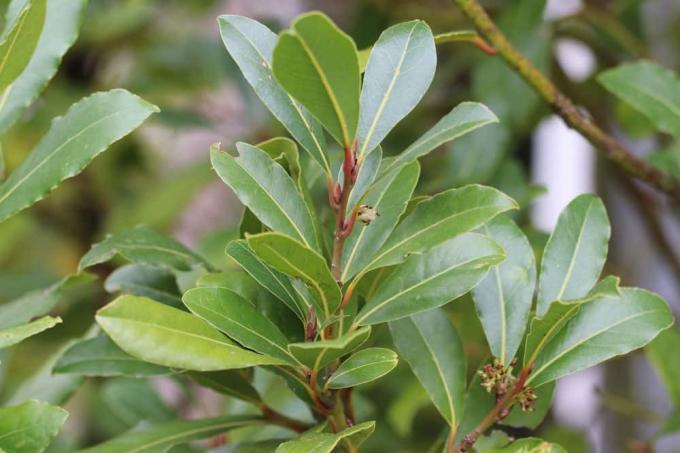
Laurel tree, Laurus nobilis - information on care, propagation and wintering
The laurel tree is a popular, evergreen shrub that is suitable for pot culture or also grows in mild locations in the garden. Cared for and neatly cut, the dark green, leathery foliage can provide breathtaking accents in entrance areas or on terraces. You can find out how to properly care for the laurel here.
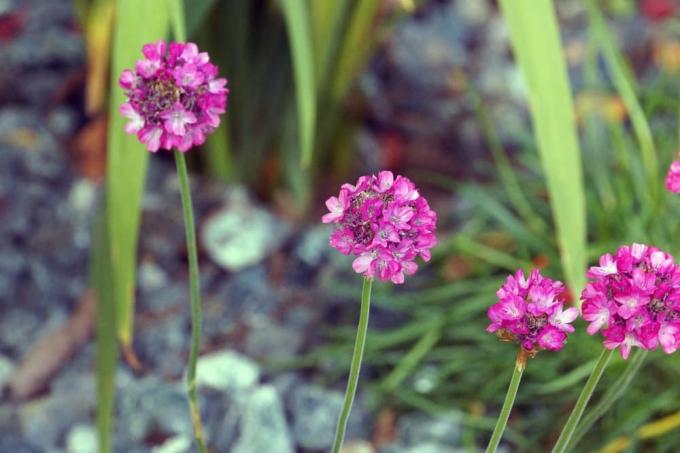
Thrift, Armeria - Varieties, care and information on winter hardiness/toxicity
Its long flowering period and uncomplicated care make the thrift a popular perennial that knows how to make a brilliant understatement. Where other summer flowers languish in the dry, sunny location, armeria trumps with colorful flowers. Explore the most beautiful varieties, practical care instructions and well-founded information on winter hardiness and toxicity.

Catchfly, Silene viscaria - sowing, planting & care
The pitcher (Lychnis viscaria) is a perennial, bushy wild perennial belonging to the Carophyllaceae family. Since it originally comes from the Mediterranean region, it is suitable for moor gardens, for green roofs, as a hardy garden perennial and as a decorative cut flower. The plant usually flowers from May to August in a strong fire or chimney red and reaches a height of about 40 to 50 cm.


